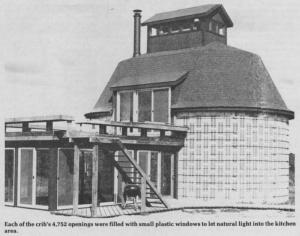1983 - Volume #7, Issue #1, Page #20
[ Sample Stories From This Issue | List of All Stories In This Issue | Print this story
| Read this issue]
Corn Crib Converted Into Country Home
 |
A former Forreston resident, Darrell Windle, and his partner, Dave Samber, converted the oval corn crib into a country summer home. They originally were interested in the site where the crib is situated for the 14 acres of wooded land and pond located on the property. However, after seeing the corn crib, they both saw the opportunity to create a unique home.
The crib was built in the early 1930s by the Mendota Corn Crib Company. Constructed of pre-cast concrete, it had a vehicular driveway in the middle. The north end was used as a grain bin while the south end was for ear storage. The cupola and roof shape are the result of clearances required for swinging the conveyor or downspout from side to side or when moving grain inside the crib.
It has taken two years to complete the renovations; one year for designing by a Chicago architect and another for construction. The work was done by local workmen.
The kitchen is located in the south end of the crib, which contains the unusual wall that consists of 4,752 natural light openings. These openings were used to circulate the air to dry the ear corn. Windle's father, George, fitted each one of the openings with a 1 1/2 inch by 4 inch piece of acrylic.
All of the cabinets and counter tops are made of Burgundy formica and are waist high so as not to detract from the wall. The shape of the counter also parallels the shape of the wall in that room.
What was once the corn crib's driveway is now the main room, a combination living/dining room, complete with a fireplace. One of the original grain chutes is still intact in the main room's ceiling.
An old pitchfork, found in the crib, rests above the fireplace and an old draft horse collar hangs on another wall in the room.
The half bath downstairs contains a porcelain pedestal sink and an antique commode that were found in an old building in Chicago. The full upstairs bath contains a modern glass block shower and the most up-to-date European fixtures.
A small den is also included in the downstairs.
A 12-foot by 22-foot addition was built onto the west side of the crib that exactly duplicates the driveway area of the original building. The room is completely surrounded by sliding glass doors and the interior is a sunken floor. The flooring and steps of this room are made of redwood and at one end of the room is a hot tub. The tub, originally used as a wine cask in California's Napa Valley,is a 4 feet deep by 6 feet in diameter.
A spiral staircase leads from the kitchen up to the loft, which consists of a master bedroom, guest room and full bath.
The glass-enclosed cupola provides a 360-degree view of the surrounding countryside. A wooden ship's ladder leads from the main bedroom up to the cupola. An acrylic floor is another feature of the cupola, which permits as much natural lightfrom above to filter down as possible. The windows can also be opened to allow the air to circulate in the lower levels.
Besides taking advantage of the natural lighting, two rows of glass block have been installed in the north side of the building. Surface-mounted can lighting in the hot tub room supplement the lighting. Double-track lighting above the kitchen area and in the cupola, which shines down into the main bedroom, was also installed.
(Reprinted with permission from Illinois Agri-News)

Click here to download page story appeared in.

Click here to read entire issue
To read the rest of this story, download this issue below or click here to register with your account number.




